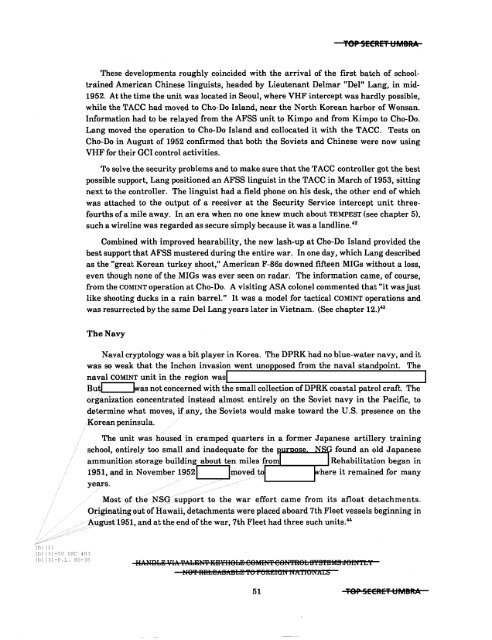American Cryptology during the Cold War - The Black Vault
American Cryptology during the Cold War - The Black Vault
American Cryptology during the Cold War - The Black Vault
You also want an ePaper? Increase the reach of your titles
YUMPU automatically turns print PDFs into web optimized ePapers that Google loves.
Tep SECRET l:JMBIbIc<br />
<strong>The</strong>se developments roughly coincided with <strong>the</strong> arrival of <strong>the</strong> first batch of schooltrained<br />
<strong>American</strong> Chinese linguists, headed by Lieutenant Delmar "Del" Lang, in mid<br />
1952. At <strong>the</strong> time <strong>the</strong> unit was located in Seoul, where VHF intercept was hardly possible,<br />
while <strong>the</strong> TACC had moved to Cho-Do Island, near <strong>the</strong> North Korean harbor of Wonsan.<br />
Information had to be relayed from <strong>the</strong> AFSS unit to Kimpo and from Kimpo to Cho-Do.<br />
Lang moved <strong>the</strong> operation to Cho-Do Island and collocated it with <strong>the</strong> TACC. Tests on<br />
Cho-Do in August of 1952 confirmed that both <strong>the</strong> Soviets and Chinese were now using<br />
VHF for <strong>the</strong>ir GCI control activities.<br />
To solve <strong>the</strong> security problems and to make sure that <strong>the</strong> TACC controller got <strong>the</strong> best<br />
possible support, Lang positioned an AFSS linguist in <strong>the</strong> TACC in March of 1953, sitting<br />
next to <strong>the</strong> controller. <strong>The</strong> linguist had a field phone on his desk, <strong>the</strong> o<strong>the</strong>r end of which<br />
was attached to <strong>the</strong> output of a receiver at <strong>the</strong> Security Service intercept unit threefourths<br />
of a mile away. In an era when no one knew much about TEMPEST (see chapter 5),<br />
such a wireline was regarded as secure simply because it was a landline. 42<br />
Combined with improved hearability, <strong>the</strong> new lash-up at Cho-Do Island provided <strong>the</strong><br />
best support that AFSS mustered <strong>during</strong> <strong>the</strong> entire war. In one day, which Lang described<br />
as <strong>the</strong> "great Korean turkey shoot," <strong>American</strong> F-86s downed fifteen MIGs without a loss,<br />
even though none of <strong>the</strong> MIGs was ever seen on radar. <strong>The</strong> information came, of course,<br />
from <strong>the</strong> COMINT operation at Cho-Do. A visiting ASA colonel commented that "it was just<br />
like shooting ducks in a rain barrel." It was a model for tactical COMINT operations and<br />
was resurrected by <strong>the</strong> same Del Lang years later in Vietnam. (See chapter 12.)43<br />
<strong>The</strong> Navy<br />
Naval cryptology was a bit player in Korea. <strong>The</strong> DPRK had no blue-water navy, and it<br />
was so weak that <strong>the</strong> Inchon invasion went unopposed from <strong>the</strong> naval standpoint. <strong>The</strong><br />
naval COMINT unit in <strong>the</strong> region wasl<br />
Butl !was not concerned with <strong>the</strong> small collection ofDPRK coastal patrol craft. <strong>The</strong><br />
organization concentrated instead almost entirely on <strong>the</strong> Soviet navy in <strong>the</strong> Pacific, to<br />
determine what moves, ifany, <strong>the</strong> Soviets would make toward <strong>the</strong> U.S. presence on <strong>the</strong><br />
Korean peninsula.<br />
<strong>The</strong> unit was/housed in cramped quarters in a former Japanese artillery training<br />
school, entirely too small and inadequate for <strong>the</strong><br />
found an old Japanese<br />
ammunitiollstorage building about ten mile~fro<br />
Rehabilitation began in<br />
1951,and in November 1~f)21 II'Oove~to here it remained for many<br />
years.<br />
Mostofth~N~gsupportto <strong>the</strong> war effort came from its afloat detachments.<br />
O~igi~~~iIlgO:l.ltofHawaii,detachments were placed aboard 7th Fleet vessels beginning in<br />
A:llgust 1951, and at <strong>the</strong> end of<strong>the</strong> war, 7th Fleet had three such units. 44<br />
I<br />
Ib) (1)<br />
Ib) (3) -50 USC 403<br />
Ib) (3) -P.L. 86-36<br />
Wi\MQbK VIA 'I'eAbKN'f IE:KYIlSbFJ eSMm'f eeU'fRSb S'IS'fI!JMS J6UofTL i<br />
US'f RFJJ::Ji!lA:SkSbl!J TO P'6ftI!:IGN NATIONALS<br />
51 'FOP SECRH tlMBR-A
















